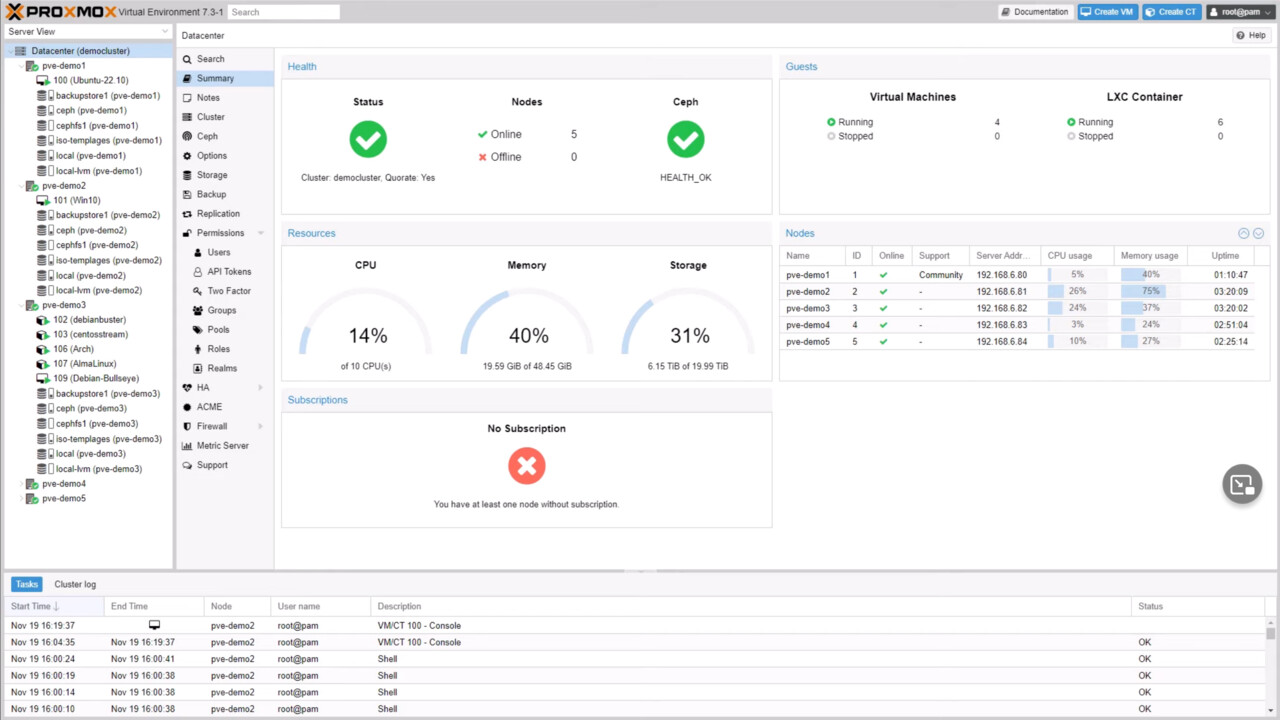Proxmox Virtual Environment 7.3: Debian 11.5 mit neuem Linux-Kernel und erstmals CRS

Die Open-Source-Virtualisierungssoftware Proxmox Virtual Environment basiert auf Debian und verwaltet virtuelle Maschinen und Container auf x86-Basis. In der neuesten Version 7.3, die wahlweise den Linux-Kernel 5.15 LTS oder 5.19 nutzt, wird erstmals initial ein Cluster Resource Scheduler als „Technology Preview“ angeboten.
Updates für QEMU, LXC, ZFS und Linux
Das Wiener Unternehmen Proxmox Server Solutions hat die neueste Version seiner Open-Source-Virtualisierungsplattform Proxmox Virtual Environment („Proxmox VE“) veröffentlicht, die jetzt auch QEMU 7.1, LXC 5.0.0 und ZFS 2.1.6 mit an Bord hat und als Basis fortan ein Debian 11.5 („Bullseye“) mit aktualisiertem Kernel nutzt.
Neben dem noch als „Technology Preview“ eingestuften Support für den Cluster Resource Scheduler (CRS), bietet Proxmox VE 7.3 laut den offiziellen Release Notes die nachfolgenden Highlights:
- Proxmox Offline Mirror: The Proxmox Offline Mirror tool allows to keep Proxmox VE nodes – with restricted or without access to the public internet – up-to-date and running.
- With the ‘proxmox-offline-mirror’ utility it’s possible to manage a local apt mirror for all package updates for Proxmox and Debian projects.
- From that mirror, users can create an external medium (USB flash drive or a local network share), and can then update their policy-restricted or air-gapped systems.
- For subscribers with a Premium and Standard subscription level, Proxmox offers an offline subscription key for its product portfolio.
- Support for Ceph Quincy and Ceph Pacific: Proxmox Virtual Environment 7.3 supports Ceph Quincy 17.2.5 as default and Ceph Pacific 16.2.10. The preferred Ceph version can be selected during the installation process.
- The Proxmox developers have added heuristical checks to see if it is safe to stop or remove a service instance (MON, MDS, OSD). If removing or stopping a service would affect the cluster operation, the web interface will now alert users with a warning.
- Overall, the usability for creating new clusters, including selecting the network and checking duplicate IP, has been improved.
Proxmox VE 7.3 – Highlights
Container für Ubuntu, Fedora und openSUSE
Zudem wurden auch wieder zahlreiche neue Vorlagen für Container der unterschiedlichsten Linux-Distributionen, wie AlmaLinux 9, Rocky Linux 9 und Ubuntu 22.10 („Kinetic Kudu“) sowie Fedora 37 und Fedora 36, zu der quelloffenen Virtualisierungsplattform hinzugefügt.
Außerdem werden auch openSUSE Leap 15.4, Alpine 3.16 und CentOS 9 erstmals offiziell mit einer eigenen Container-Vorlage unterstützt, während Arch Linux und Gentoo jeweils ein aufgefrischtes „Template“ erhalten.
Bereits seit dem Release von Proxmox VE 7.1 können alle verfügbaren Container-Templates mit dem verlustfreien Datenkompressionsalgorithmus Zstandard (Zstd) komprimiert werden. Die offizielle Pressemitteilung (PDF) nennt noch weitere Verbesserungen und Details der neuesten Version von Proxmox VE.
Update und Download
Ein Update auf Version 7.3 ist aus bestehenden Installationen heraus mittels GUI und Shell sowie SSH problemlos möglich. Für Neuinstallationen steht das Proxmox Virtual Environment 7.3 ab sofort in verschiedenen Ausführungen zum Download bereit.
Ein Video stellt alle Neuerungen, die auch der Roadmap entnommen werden können, im Detail vor.
Hinweis: Aus dem ComputerBase-Forum kommt ein Leserartikel zum Thema Proxmox, den der ComputerBase-Leser „xCtrl“ ins Leben gerufen hat und der insbesondere für Einsteiger auf dem Gebiet aber auch für erfahrene Anwender sehr lesenswert ist.
- [Leserartikel] Proxmox VE: Alleskönner mit virtuellen Gaming-Ambitionen?
Die Redaktion dankt Community-Mitglied „Poulton“, der die Redaktion auf das Release von Proxmox VE 7.3 hingewiesen hatte.
Proxmox Backup Server 2.3 erschienen
Rund eine Woche nach dem Release von Proxmox Virtual Environment 7.3 haben die Entwickler auch den neuen Proxmox Backup Server 2.3 veröffentlicht.
Die Basis ist auch hier Debain 11.5 („Bullseye“) mit Linux 5.15 LTS als Standard-Kernel. Als Opt-in für akutelle Hardware steht außerdem Linux 5.19 zur Auswahl. Erstmals mit an Bord ist zudem ZFS in der Version 2.1.6.
Die Entwickler versprechen einen besseren Schutz vor Ransomware, sogenannten Erpressungstrojanern, und ein verbessertes Web-Interface zur Installation und Administration des Backup-Servers.
- Enhanced Ransomware protection
- Enhancements in the Web Interface
- Native Support for Sending Periodic Metrics to InfluxDB
- TLS certificate validation can be disabled for HTTPS endpoints
- Support Proxmox Offline Mirroring & Subscription Handling
- Support for HTTP(S) and UDP endpoints
- Add Namespace Aware Prune Jobs
- General Backend Improvements
- General Client Improvements
- Tape Backup Improvements
Weitere Informationen liefern die Ankündigung sowie die offiziellen Release Notes.


